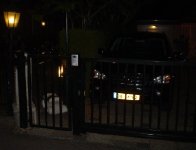more than that
i thing that with somany out devices and 52 volts per rail will produce a hell of a lot more than 100w
i thing that with somany out devices and 52 volts per rail will produce a hell of a lot more than 100w
Re: more than that
its motorola culculation 🙂
sakis said:i thing that with somany out devices and 52 volts per rail will produce a hell of a lot more than 100w
its motorola culculation 🙂
Designed by Andy Hefley of Great American Sound co. (GAS) , there was also another application note from this series that was essentually an updated Ampzilla design.
Mike
Mike
"i thing that with somany out devices and 52 volts per rail will produce a hell of a lot more than 100w"
If you used a fully regulated power supply it would.
The Adcom GFA 535 was only rated at 60W/8R with +/- 52V.
If you used a fully regulated power supply it would.
The Adcom GFA 535 was only rated at 60W/8R with +/- 52V.
Motorola Amp.
I thought that design looked familiar. 52 volt rails should give you close to 100w into 8ohms. Looks like a good project for a p.c. board layout. Would be an easy build for newbies.
I thought that design looked familiar. 52 volt rails should give you close to 100w into 8ohms. Looks like a good project for a p.c. board layout. Would be an easy build for newbies.
If i had not seen my agenda calendar lately this would have been a nice April fool schematic.
Whoever exchanged the output stage must have transplanted a Vette LS6 engine in his 80s Buick Century stationwagon as well.
Whoever exchanged the output stage must have transplanted a Vette LS6 engine in his 80s Buick Century stationwagon as well.

This design embodies the low feedback school , with the VAS stage severely loaded by two 2K7 resistors to ground...
It's not a very low distortion amp... 😉
It's not a very low distortion amp... 😉
Tube_Dude said:This design embodies the low feedback school , with the VAS stage severely loaded by two 2K7 resistors to ground...
It's not a very low distortion amp... 😉
What if one eliminated the 2.7K and the snub network from the VAS? The output (albeit overbuilt) reminds me of a low-TIM design from the now defunct Mark-V Electronics kits.
stahlight said:
What if one eliminated the 2.7K and the snub network from the VAS?
If you eliminated the two 2.7K resistors the distortion go down.
If you eliminated the the snub network the amp go to heaven ... unless you use another type of compensation... 😉
The story of this amp should begin with:
Once upon a time Leach met Borbelly and they drank loads of vodka...
Once upon a time Leach met Borbelly and they drank loads of vodka...
This amp lacks Triple deep darlington Emitter Follower output stage, which is a must for any BJT amp atleast.....very low current gain is the key feature[drawback] of this amp....But i like the local feedback at VAS stage...😉
jacco vermeulen said:Whoever exchanged the output stage must have transplanted a Vette LS6 engine in his 80s Buick Century stationwagon as well.
OT -- Buick Century had a pretty big V6 -- but I don't know if you could fit an LS in there -- I owned one AND an Oldsmobile "Custom Cruiser" wagon at the same time in the early 1980's.
jackinnj said:
OT -- Buick Century had a pretty big V6 -- but I don't know if you could fit an LS in there -- I owned one AND an Oldsmobile "Custom Cruiser" wagon at the same time in the early 1980's.
So you had the opportunity to do it, but didn't? I think that answers the question. It didn't fit. 🙂
My name José J make joke again.
The Century had front wheel drive and was manufactured with the notorious LT6 V6 Diesel engine option.(just like Olds Cutlass + Pontiac 6000)
Worst cars with the worst diesel engine in the world, 86 horsepower from 262ci. (when it worked)
Swap LT6 for LS6, get it ?
The Century had front wheel drive and was manufactured with the notorious LT6 V6 Diesel engine option.(just like Olds Cutlass + Pontiac 6000)
Worst cars with the worst diesel engine in the world, 86 horsepower from 262ci. (when it worked)
Swap LT6 for LS6, get it ?
Nice amplifier...and folks love Mopar too.
I have a neighboor with a Chevelle Malibu...he parks in front of my house... I love that car.
I found this one in my garage...ahahahahah.
This Motorola amplifier is fine my friend...sorry by this fast off topic....i am going.
gone!
Carlos
I have a neighboor with a Chevelle Malibu...he parks in front of my house... I love that car.
I found this one in my garage...ahahahahah.
This Motorola amplifier is fine my friend...sorry by this fast off topic....i am going.
gone!
Carlos
Attachments
Workhorse said:lacks Triple deep darlington Emitter Follower output stage
Funny enough, the 200 watt version of this 10 year old experiment for the shortlived Motorola 2SA1302/2SC3281 "clones" does copy the Locanthi triple darlington output from the original low feedback amp developer. A Leach amp is more attractive, that or go hip with the OnSemi amp in the 2005 application note.
Carlos,
don't start on Beetles, in a few months from now i'm having my neighbor over for the summer BB-Q and he'll be working me over again to fix his VW.
His Beetle convertible always sleeps in the garage, while the AMG ML5.5 and brandnew Saab V6T Aero convertible are outside day and night.
(took me a year and a half to convince him to get an electric fence)
Attachments
Tube_Dude said:This design embodies the low feedback school , with the VAS stage severely loaded by two 2K7 resistors to ground...
It's not a very low distortion amp... 😉
Why? It's fully complementarized (with some little tricks on input stage/VAS interface which further enforce the complementarization). IMHO a THD not greater than of 0.05 % at roughly 80 Watt RMS is to be expected even with low feedback.
The real concern, as in neither all "low NFB" design, are on PSRR side rather than THD or "inner" data. But this is pretty common to this kind of schematics; "lowering NFB" really mean "displacing NFB" from the inner to the outer side of amplifier - in this case mean: the use of a elecronic stabilized PSU if foreseable and that imply, of course, the use of some amount of NFB... outside the main amplifier! 😉
Hi
Piercarlo
- Status
- Not open for further replies.
- Home
- Amplifiers
- Solid State
- Motorola Power Amplifier

